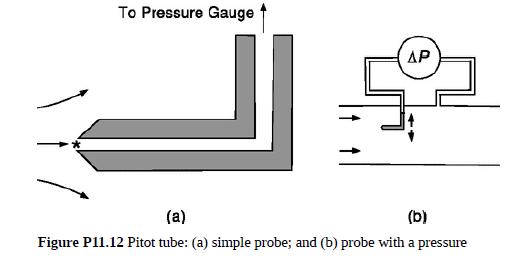The Pitot tube, invented by the French engineer Henri Pitot (16951771) to measure fluid velocities, has various
Question:
The Pitot tube, invented by the French engineer Henri Pitot (1695–1771) to measure fluid velocities, has various forms. Pitot tubes are used to monitor the airspeed of commercial jets, as anemometers in weather stations, and in industrial or laboratory settings to determine local velocities or velocity profiles. The simplest type of probe, shown in Fig. P11.12(a), is a fluid-filled tube with a tapered end that is pointed at the flow. A connection to a pressure gauge keeps the internal fluid static and creates a stagnation point at the tip (marked by *). The pressure difference between the internal fluid and a nearby reference point where the fluid is static is used to infer the velocity near the tip. The setup in Fig. P11.12(b), where the reference is a tap in the tube wall, could be used to measure the velocity profile by varying the radial position of the probe. (In a Pitot-static tube, the reference is a second internal channel that is connected to the outside by holes on the side of the probe. That eliminates the need for a wall tap or other separate connection to static fluid.)
![]()
Derive the relationship between the fluid velocity and the measured pressure difference. You may assume that height differences are negligible.
Step by Step Answer:

Introduction To Chemical Engineering Fluid Mechanics
ISBN: 9781107123779
1st Edition
Authors: William M. Deen





